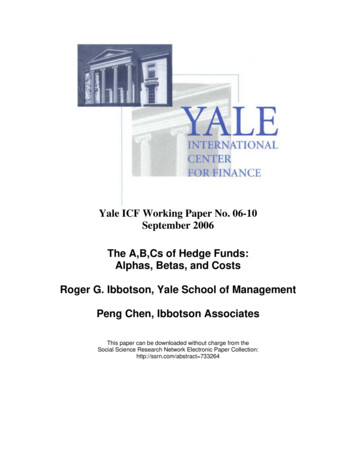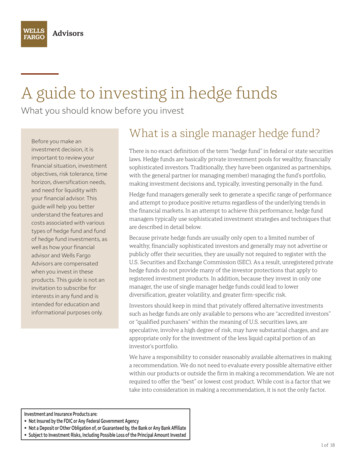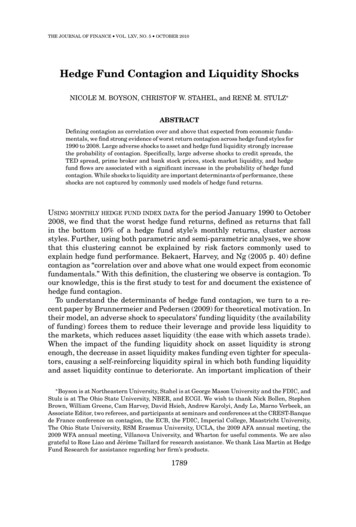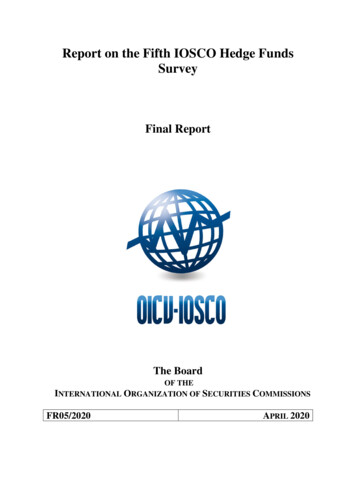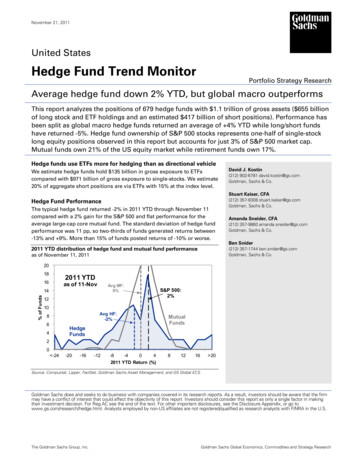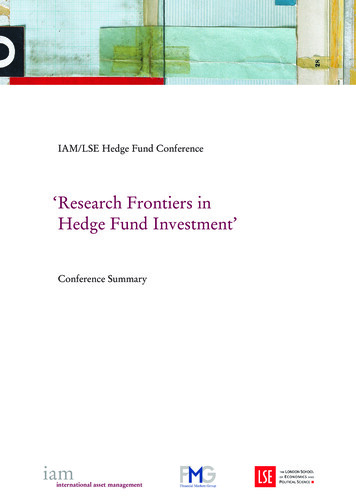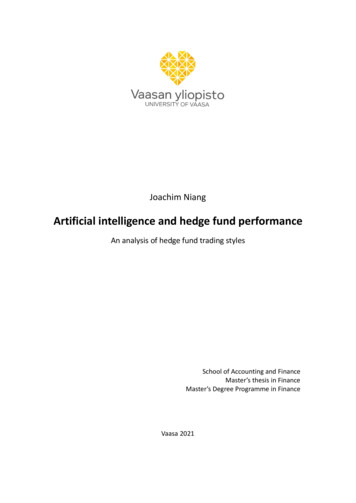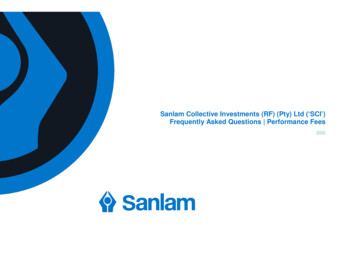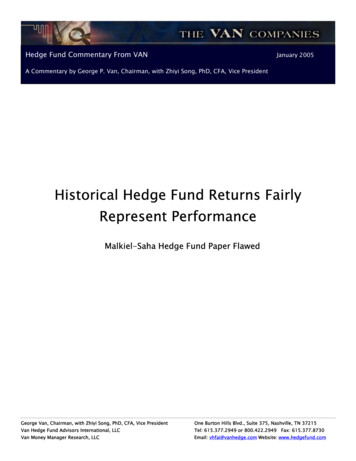
Transcription
Hedge Fund Commentary From VANJanuary 2005A Commentary by George P. Van, Chairman, with Zhiyi Song, PhD, CFA, Vice PresidentHistorical Hedge Fund Returns FairlyRepresent PerformanceMalkiel-Saha Hedge Fund Paper FlawedGeorge Van, Chairman, with Zhiyi Song, PhD, CFA, Vice PresidentOne Burton Hills Blvd., Suite 375, Nashville, TN 37215Van Hedge Fund Advisors International, LLCTel: 615.377.2949 or 800.422.2949 Fax: 615.377.8730Van Money Manager Research, LLCEmail: vhfai@vanhedge.com Website: www.hedgefund.com
Historical Hedge Fund Returns Fairly Reported2Malkiel-Saha Hedge Fund Paper FlawedTable of Contents:Page1. Background32. Malkiel-Saha Paper Flaws and Our Comments on Potential Biases43. Validation Studies of the Van Global Hedge Fund Index84. A Helping Hand105. Some Interesting Ironies15Appendix A: Van Index Methodology18Appendix B: List of Exhibits33Explanatory Notes34Selected Sources35AcknowledgementsOur thanks to these VAN officers, for their thoughts and contributions:Daniel Hayden, Managing DirectorJohn Van, Managing DirectorTimothy Weaver, Vice PresidentThomas Whelan, President and CEOVan Hedge Fund Advisors International, LLCVan Money Manager Research, LLC
Historical Hedge Fund Returns Fairly Reported3Malkiel-Saha Hedge Fund Paper Flawed1. BackgroundRecently, a paper on hedge fund (“HF”) databases and indices, entitled “Hedge Funds: Riskand Return” (“paper”) was released to the major media. Its authors were Burton Malkieland Atanu Saha, both economists.Malkiel and Saha use an unrepresentative sample and then generalize that other HFindexes are similarly flawed.Mr. Malkiel is associated with the mutual fund industry. He has been a director ofVanguard since 1977. Vanguard is the largest mutual fund provider of index funds andthe third largest mutual fund company. He also has been a director of another indexprovider, Active Index Advisors. Evidence shows the mutual fund industry is becomingincreasingly concerned about the rise of HFs. Malkiel also is a proponent of theproposition that you can’t beat general market indexes – which HFs have. In fact, he hasbuilt his career on this proposition.His co-author, Mr. Saha, is billed on his company website as “an expert in damageanalysis” and “litigation”.The Malkiel-Saha paper, with its numerous flaws, does a disservice to both investors andthe media.Note: VAN refers to Van Hedge Fund Advisors International, LLC and its affiliates, while VMMR refers specifically toVan Money Manager Research, LLC.Van Hedge Fund Advisors International, LLCVan Money Manager Research, LLC
Historical Hedge Fund Returns Fairly Reported4Malkiel-Saha Hedge Fund Paper Flawed2. Malkiel-Saha Paper Flaws and Our Comments on Potential BiasesThe study appears to betray a lack of understanding of the basic differences between HFdatabases and HF indices and their uses. It also seems to point out a general lack ofknowledge of the procedures HF index providers use in maintaining their indices.Finally, the authors choose a database apparently replete with backfilling throughout itshistory and then make the incredible and incorrect leap, without further investigation,that all HF indexes include similar backfilling and biases.This is the biggest flaw of the paper. Throughout, the authors seem to believe that HFreturns, as reported in the indices, are inflated by the inclusion of earlier track records ofnew funds added. This is incorrect regarding the VAN database and, we would hope,others. VAN demands, and we believe all serious database sponsors demand, inclusion ofthe earlier records of any HF wishing to be in the database, in order to have available thecomplete track record of that fund. However, index returns are calculatedcontemporaneously with reporting of the data. For a given month or year, these returnsdo not change, regardless of the previous records of new funds added to the database.This is the distinction between databases and indexes. The exception, at least in the caseof VAN, is the first year inception of an index when prior year returns of funds are used tocreate prior years’ indexes.For instance, VAN began its HF index in 1994. Funds collected in 1994 were required toprovide their total records since inception. They were told that if they did not, they wouldnot be accepted. There was no selection by VAN of parts of records, as the authors,apparently with no evidence, suggest is done throughout the industry. We cannot recall asingle instance of any fund’s refusal to provide a complete record. This protocol wasestablished to ensure that bad performance was not hidden. So, from 1988 through 1994(six years), there was not a backfilling bias, as it is described by the authors, but webelieve there undoubtedly was some survivorship bias. Between 1994 and 2004 (tenyears), the VAN Index data contains neither backfilling bias (as described by the authors)nor survivorship bias (also described below).Survivorship bias simply means that on the day an index is established, it will have accessonly to funds in existence at that time. The index will not be able to include, in its preinception history, funds that previously closed for any reason; e.g., the fund failed; themanager, awash in cash after good performance, or “stressed out”, decided to retire ortake time off; the fund was bought out by a financial services company or merged withanother fund.While survivorship bias can depress or inflate returns, in fairness, failed funds probablyrepresent the single largest group of funds missing from the VAN index in the years1988-1994.Van Hedge Fund Advisors International, LLCVan Money Manager Research, LLC
Historical Hedge Fund Returns Fairly Reported5Malkiel-Saha Hedge Fund Paper FlawedWhile the other circumstances listed above tend to unfavorably lower the pre-inceptionindex returns, the omission of failed funds, in this same pre-inception period, would havethe contrary effect. The net effect probably would be that returns would tend to beslightly inflated in the pre-inception period by survivorship bias, but not, at least in thecase of VAN, by “backfill bias”.Backfill bias appears to be defined by the authors primarily as the raising of HF indexreturns by (selectively) including the better previous returns of new funds coming into thedatabase. Again, the authors appear confused between the returns of the database(which does not report returns), and the returns of the index which does report returnsbut does not, in a serious index like VAN’s, accept backfilling. Therefore, the authors’claims that HF index returns (including those of the VAN Index and other indexes) areinflated is, at least in the case of VAN, erroneous from 1994 to the present.It is important to note that their generalizations on HF indices, at least in the case of VAN,were arrived at without any contact whatsoever with VAN (other than downloading onlybasic information from our website) or any attempt to understand VAN’s databasemaintenance and index protocols. The Malkiel-Saha research paper makes similar giantleaps of logic elsewhere as well, without evidence.Based on information produced by Schneeweis1, at least one other HF industry index likeVAN’s does “not contain either survivorship bias or backfill bias” for the last ten years orso.Also based on Schneeweis, it is possible that a major mistake made by the authors was touse an unrepresentative sample. While VAN has no independent knowledge of the CSFBdatabase, Professor Schneeweis states that using the CSFB database “most likely grosslyoverestimates the potential backfill bias ”. “Of the various databases, the CSFB-Tassdatabase is largely affected by backfill. The Tass database was expanded in the late1990’s when it was purchased by CSFB. At that time, it is reasonable to assume thatmany funds were added to their database ”.The authors then create their own index with and without old (“backfilled”) CSFB/Tassreturns from 1994-2003. They conclude that the reported HF index returns wereunjustifiably high because of the backfilled returns from 1994-2004.Although this study does show that backfilling does exist in the CSFB/Tass database,there were no backfilled returns from 1994-2004 in the VAN Index, nor do we believethat backfilling indices has been the case, post-inception, for any major index provider.1Schneeweis, A Check On “A Reality Check on HFs”, cisdm@som.umass.edu. A CFSB representative subsequentlyhas stated that, technically, the TASS database was not acquired by CSFB.Van Hedge Fund Advisors International, LLCVan Money Manager Research, LLC
Historical Hedge Fund Returns Fairly Reported6Malkiel-Saha Hedge Fund Paper FlawedA HF database is simply a repository of HF records to be used as an aid in assistinginvestors, creating portfolios, etc. When current HF returns arrive monthly, whether fromnew funds discovered, or existing funds, only that month’s returns are used in the index.As stated above, prior records of new HFs (new to the company) go with the fund into thedatabase as a record for future use but do not affect the index. Again, in the case ofVAN, the full past records that go into the database do not go into the index.Part of the difficulty in interpreting this paper is that, if one is familiar with HFs and theHF industry, it is difficult to see through the eyes of authors who lack familiarity with theindustry. The conclusion that overall “HF [returns] are substantially upward biased” due tobackfilling, based on data observed in one database does not follow. One should notconfuse returns in a database with returns from an index with contemporaneouslyreported returns. Aggregate returns from a database are not provided the public orinvestors, at least not by serious database sponsors.Unfortunately, Malkiel and Saha then go on to impugn the integrity of all index providers.They state that when HF managers begin reporting to databases, “the most favorable ofthe early results are then (backfilled) into the database along with reports ofcontemporaneous results.” The authors conclude this after study of one database andmake the leap, apparently without evidence, that this practice is followed by other indexsponsors.Further, no mention or consideration is given to the fact that some of us have beenRegistered Investment Advisors for many years. As such, our activities are examined bythe S.E.C. In these circumstances, there can be no room for shenanigans.They all appear to be fine fellows with whom one would enjoy a cookout. But why thisgeneralized attack on the HF industry? Perhaps there is more “bad data” out there thansome of us believed. However, it seems unlikely that this is the case for long-standing HFindices, managed by leading companies with the same management over time and by thesame sponsors since inception.End-of-Life Reporting Bias: this occurs, they say, when funds “stop reporting their resultsduring the last several months of their lives.” In reality, this does occur, but it is soinconsequential compared to other factors that it isn’t worth the effort to study it. Theyuse Long-Term-Capital-Management (“LTCM”), picking the ultimate extreme example,and describe it as losing 92% of its capital between October 1997and October 1998. Theyadd: “none of these negative returns were reported to the database providers.”They neglect to say that LTCM stopped reporting to virtually all database providers in itsearly years when they became Masters of the Universe, racking up eye-popping returns.Databases (and Indexes), therefore, did not receive the benefits of their high returns.Almost all index providers are equal-weighted rather than asset-weighted. We estimatethat had LTCM been in the VAN database in October 2004 for example and reported aVan Hedge Fund Advisors International, LLCVan Money Manager Research, LLC
Historical Hedge Fund Returns Fairly Reported7Malkiel-Saha Hedge Fund Paper Flawedtotal loss of their capital in this one month, as –100%, it would have had an effect onOctober’s index return of 0.08%; i.e., the index return would have dropped from 0.64% to0.56%. Since we round the VAN index to the nearest tenth of a percent, it would haveremained at 0.6%. It therefore hardly seems worth getting into a snit over this end-of-lifebias, even over LTCM as an example.(There is a certain irony that this may be the first time in years that I have seen LTCMmentioned without the accompanying descriptor that its senior team includedprominently two economists - who were Nobel laureates )In emphasizing the importance of End-of-Life Reporting Bias, the authors then quote astudy by Posthuma and Van der Sluis, which puts HF returns in a bad light. This laststudy made the outrageous assumption that, in the last month after ceasing reporting toa database, all such funds had negative returns of 50%! As my friends in the Torontogarment district would say, “For this I need a Ph.D.?”As it happens, the Posthuma and Van der Sluis assumption mentioned above generallyappears not to have been accepted by most academics.As described elsewhere, there are reasons for a HF to stop reporting that could slightlyelevate indices as well as reasons that could slightly depress an index – causing it tounderstate the returns of the HF universe.VAN retains all funds in its database, dead, dying or alive, as well as in the index. We alsorecord all reported losses in the database (and in the index should that fund be in theindex). Should a fund become terminal, we seek to obtain the magnitude of the loss. Asthe LTCM example above shows, the end-of-life reporting bias is hardly worth spendingmuch time on.Van Hedge Fund Advisors International, LLCVan Money Manager Research, LLC
Historical Hedge Fund Returns Fairly Reported8Malkiel-Saha Hedge Fund Paper Flawed3. Validation Studies of the Van Global Hedge Fund IndexVAN has performed subsequent testing of the previously reported VAN Indices to monitorfor various biases and to determine if larger sample sizes from the VAN database wouldyield significantly different results.The larger sample from the database included several different components: first, returnsfor HFs that reported to the database prior to the time of the Index; second, those thatwere entered into the database as they were contemporaneously reported in the Index;third, funds that were not included in the Index because they reported late; fourth, fundsthat were added to the database subsequent to the date of the Index, not included in theIndex, and whose prior returns were backfilled in the database, but not the index.These samples, on average, were three times the size of the Index.Exhibit 1: Linear Regression: Historical Van Index vs. Larger Sample from DatabaseValidation of the Historical IndexIndex Versus Recalculated ecalculated ValuesReported IndexPredicted Index ValueA linear regression study establishes how well-correlated the published Index is with acomputation made by re-sampling all the funds in the database that have reported in thesame periods. This re-sampling process yields sample sizes averaging more than threetimes the number of funds used in the contemporaneous computations previouslyreleased. The study determines whether the larger, more robust sample of funds wouldprovide a different measurement of the historical returns of the HF industry. The resultsof this study indicate that the previous sample sizes were adequate to produce validresults.Van Hedge Fund Advisors International, LLCVan Money Manager Research, LLC
Historical Hedge Fund Returns Fairly Reported9Malkiel-Saha Hedge Fund Paper FlawedThe published Index shows a .99 correlation to the re-sampled data. Additionally, thebeta exceeds .96. A small quarterly alpha of .29% indicates the existence of, what webelieve to be a limited degree of early reporting bias in the population.Conclusions to be drawn from this study are as follows: first, the Index fairly tracks theHF universe based on comparison to an unbiased, fairly reported sample and second, thepresence of legitimately (unbiased) backfilled data in the database does not noticeablyaffect database returns; third, if biased backfilled data had been present in the database(which was not the case) the larger database sample would have produced significantlyhigher returns than the VAN Index. It did not. (As noted elsewhere, the VAN Indexincluded only contemporaneously reported returns for each period, beginning in 1994,was fixed as of a given date for that period, and was not changed subsequently.)The aggregate growth of a 1,000 investment was graphed to review the extent oftracking error. Due to the high correlation and high beta of the data, tracking error wasminimized. However, the hypothetical investment compounded to a greater value usingthe published Index due to the alpha produced by the data.Exhibit 2: Growth of 1,000: Historical Van Index vs. Larger Sample from DatabaseTracking the Historical Index - Growth of 1,000January 1988 through December pled Data21,000Original IndexBased on the close statistical relationship between the published Index and the averagehistorical returns of a significantly larger sample of funds, the Index reflects the larger HFuniverse.Van Hedge Fund Advisors International, LLCVan Money Manager Research, LLC
Historical Hedge Fund Returns Fairly Reported10Malkiel-Saha Hedge Fund Paper Flawed4. A Helping HandIt is interesting that, with virtually no exceptions, the paper in question discusses onlyfactors that allegedly increase HF index returns, thus permitting the authors to claim thatHF returns are overstated.Why do they not consider some very important factors that cause HF returns to beunderstated? We’d like to help them out here and put forth a few factors that cause HFindex returns to be lower than they should be.First, let’s talk about funds which stop reporting. After over twelve years of closelyobserving HFs worldwide, we are seeing a higher percentage of funds closing to newmoney than ever before. This is due to an unprecedented amount of money seeking thebest-performing funds. In the 1990’s, most fund managers were geniuses. Now, therearen’t so many. When we now do screens of HFs, up to 50% of the top quartile funds2 areclosed. Most continue reporting to us. Some do not if we have no money with them. Andthey won’t bother reporting to many database sponsors who publish indices. So – thiscauses HF returns to be understated.Let’s now look at HFs that never report in the first place. Some are doing very well, thankyou. Their returns have been very high for years. They do not need new investors. Infact, many periodically return money to their investors, to keep from being overloaded.Here is a very small sample.3:Exhibit 3: Leading Hedge Funds: Several Are Not Represented in Hedge Fund IndicesFundAssetsCAR4ManagedCaxton Associates 11.5 billion30%GLG Partners 11 billionn/aFarallon Capital 9.9 billion22%Citadel Investment Group 9.5 billion28% 8 billion18%Tudor 7.8 billion26%Cerberus Capital 7.5 billionn/a(Bruce Kovner)LondonManagementOch-Ziff CapitalManagementManagement2Selected by a proprietary VAN algorithm.3Various public sources including Institutional Investor4Compound Annual Return; CSFB representatives have noted that their indices include several funds in Exhibit 3.Van Hedge Fund Advisors International, LLCVan Money Manager Research, LLC
Historical Hedge Fund Returns Fairly Reported11Malkiel-Saha Hedge Fund Paper FlawedSelected Others 5, 6:FundSizeCAR 6 billion16%Medallion Fund 5 billion38%Moore Global Investments 4 billionn/aSAC CapitalHighbridge CapitalManagement 4 billion48%Kingdon Capital Management 3.521%Tewkesbury Investment Fund 3 billionn/aRaptor Global Fund 3 billionn/aTudor BVI Global Fund 3 billionn/aPerry Partners 3 billion16%Appaloosa 2.8 billion34%Omega Advisors 2.8 billionn/aOf the above funds, Caxton, Moore, SAC, Perry and Appaloosa are funds that ceasedreporting to us, and to our knowledge, to everyone else.Their returns would have added to HF index returns.According to an Institutional Investor report, assets for the 100 largest managers totaled 339 billion at the end of 2003. This represents over a third of HF assets worldwide.Many of these 100 largest are closed to new money and unlikely to be included in HFindices. They got big and stayed big by posting strong returns.Obviously indices reporting HF returns are lower than they would be if they included theabove funds mentioned above. Even more compelling is the fact that many of the fundsrepresenting one third of the industry (asset-weighted) are not in HF indices. Even on anequal-weighted basis, the omission of the high returns of these funds has a depressiveeffect on index returns. We believe this effect counteracts the factors which (Malkiel andSaha state) increase HF index returns.We contend, for all the reasons stated in this paper, that HF index returns fairly representthe performance of the HF universe and, in the case of asset-weighted indices, mayunderstate that performance.5Assets approximate; returns shown where available and are net of all fees6Various public sources including Institutional InvestorVan Hedge Fund Advisors International, LLCVan Money Manager Research, LLC
Historical Hedge Fund Returns Fairly Reported12Malkiel-Saha Hedge Fund Paper FlawedLet’s now deal briefly with a few residual issues of the Malkiel-Saha paper. “A typical fee [is] 2% of the assets under management plus 20% of profits.”(Page 5)A more typical arrangement, based on VMMR data, is 1% and 20%. “ there is a tendency in our data set for larger funds to outperform smallerones.”(Page 10)If one can accepts the reasonable proposition that younger funds tend to besmaller, our data set provides contrary results, as shown below.Exhibit 4: Hedge Fund Performance as Funds Age Fund YearAverage Net ReturnNumber of Funds 3512.34%478611.84%342711.39%239Fund YearAverage Net ReturnNumber of Funds 33%30133.16%19149.75%10“Indeed, the probability of observing repeat winners over the entire period isbasically 50-50.”(Page 13)If an IQ-challenged investor used no selection criteria whatsoever in selecting funds, thismight be the case.However, in testing the viability of constructing the Van Investable Index Fund to track the16 year track record of the VAN HF Indices, VAN examined HF returns from 1996through 2002 and ranked funds with a proprietary scoring system based on severalquantitative factors. The ranked funds were divided into four quartiles, from highest tolowest rank. If persistence of performance did not exist, one would expect an equalpercentage of funds from the highest ranked first-year category to end up in each of thequartiles for the following year. The study found that top-ranked funds, chosen withVAN’s proprietary scoring system, in a given year, generate performance in the top 25%for the subsequent year approximately 40% of the time. (This finding was statisticallysignificant). Furthermore, these top ranked funds end up in the bottom 50% of funds thefollowing year only 30% of the time. The study found that negative performance persistsas well. It is important to note that we believe a qualitative overlay needed to be used, forfactors not covered by a purely mathematical model, e.g., ethics of the manager, capacityof the fund, etc.Van Hedge Fund Advisors International, LLCVan Money Manager Research, LLC
Historical Hedge Fund Returns Fairly Reported13Malkiel-Saha Hedge Fund Paper FlawedExhibit 5: Persistence of Hedge Fund Performance60%50%40%30%20%10%0%Bott o m 5 0%Next 25%Bot t om 50 % P rior YearT o p Quart ileTo p Perform ers Prior YearVAN conducted several variations on this study, examining HFs overall as well as byindividual strategy.Our conclusion is that the persistence of HF returns is statistically robust. Based on theperformance criteria and ranking system developed in the course of our studies, VANbelieves that it is possible to identify funds that have a higher-than-average probability ofgenerating superior returns. “The practice of backfilling only favorable past results causes some reportedHF indexes to be substantially upward biased.”(Page 24)We find it inconceivable that a major HF index producer would do this. VAN doesnot. The authors make the assumption that it is widespread industry practice,apparently with no evidence. They certainly gathered no such evidence on VAN’sindices.What is the authors’ evidence that some index sponsor engaged in “backfillingonly favorable past results”? Who does? “ these diversified [FOFs] performed much less well than the industry as awhole.”(Page 25)Van Hedge Fund Advisors International, LLCVan Money Manager Research, LLC
Historical Hedge Fund Returns Fairly Reported14Malkiel-Saha Hedge Fund Paper FlawedWhile VMMR research also shows that HF FOFs obtain lower returns than the HFindex, we find it unusual that, throughout the study, primarily returns, and notrisk, are taken into account. FOFs may have lower returns, but they also havelower risk.The HF industry is about risk control. Any study of HFs should emphasizerisk/volatility as well as returns.Van Hedge Fund Advisors International, LLCVan Money Manager Research, LLC
Historical Hedge Fund Returns Fairly Reported15Malkiel-Saha Hedge Fund Paper Flawed5. Some Interesting IroniesThis overall situation is replete with ironies. Let’s set the stage with a brief discussion ofthe current status of the mutual fund industry.The Investment Company Institute (ICI) represents mutual funds. Reading recentpronouncements by its Presidents, you can hear their concern.In April 2033, the Investment Company Institute made a presentation on HFs to the S.E.C.Roundtable on HFs. Along with numerous restrictions on HFs they urged the S.E.C. toimpose, they stated:“The Institute believes it is very timely for the Commission to consider whether thishistorical “hands off” approach remains appropriate or should be modified in somefashion. This is because of the significant increase in the number of HFs, the number ofentities sponsoring HFs and the number of individuals investing in or otherwise havingexposure to HF investments. In light of the importance that mutual funds and otherregistered investment companies have assumed as financial intermediaries, the extensiveregulation to which they are subject, and the far less risky investment strategies that theytypically pursue, the Institute believes that it is critically important that the Commission’sregulations insure that no investor confuses a HF with one of these highly regulatedinvestment vehicles. Equally importantly, no investor should inadvertently be drawn toinvesting in HFs.”7This statement that mutual funds are “far less risky” is ironic; during the recent bearmarket, from April 2000 to September 2002, mutual funds lost –41.3% while HFs gained2.1%.It is significant that the heretofore sovereign and self-assured mutual fund industry wouldeven acknowledge the possibility of a threat from hfs.The mutual fund industry concern goes back a number of years but has intensified as HFshave burgeoned. In 2001, David Jones of Fidelity told members of the ICI:“Stock baskets, exchange-traded funds, HFs and other new products are not going toeclipse the conventional mutual fund industry ”7Investment Company Institute, “Statement of the Investment Company Institute”, Securities and ExchangeCommission Roundtable on HFs, April 30, 2003Van Hedge Fund Advisors International, LLCVan Money Manager Research, LLC
Historical Hedge Fund Returns Fairly Reported16Malkiel-Saha Hedge Fund Paper FlawedJones of Fidelity went on to wonder:“ whether it was good policy to offer HFs to investors. ‘What you are really offering’, hesaid, ‘is higher fees, less liquidity, less disclosure - saying you are so rich andsophisticated you deserve to pay more for less.”8More recently, in August 2004, the Chicago Tribune quoted mutual fund industrymembers as intimating the brain drain to HFs could intensify.“I think we’re going to have some talented investment people who say, ‘There’s got to bea better way’, Charles Haldeman, the chief executive of Putnam Investments, said in arecent visit to Chicago.”9And in June 2004:Paul Stevens, who succeeded Matt Fink as the ICI’s president June 1, also pointed a fingerat HFs. “Unregistered HF advisers oppose even a modicum of regulation because, well, itmight screw up their business mode”, he said.”10The mutual fund industry is seriously concerned about HFs for at least three reasons:The first reason is the continual brain drain from mutual fund companies to HFs. Itstarted in the late ‘90’s, perhaps inspired by (ex-Fidelity Magellan) Jeff Vinik’s incredibleHF record.After leaving Fidelity under pressure in the mid ‘90’s, Jeff quickly rounded up over 800million, stopped raising money and began investing. Four years later, at the tender age of41, he returned 4 billion to his original investors and retired. Notwithstanding theprofessional skepticism about HFs exhibited by mutual fund industry participants, mostwould agree that Jeff Vinik’s HF beat the indexes!Jeff’s example inspired a continuing stream of wannabe hedgies to leave their mutualfund trading jobs. The defections continue apace today. And why not? As a successfulHF manager, they can earn fortunes – with little bureaucracy. The average take-home payfor the top 25 HF managers in 2003 was 207 million – cash; for the top 5, 506 million –cash!11The second reason for the ICI’s concern about HFs is the accelerating growth of the HFindustry. HF assets are now at 1 trillion for the first time, while mutual funds are at 7.689Fund Action, “Threat From New Products Ma
Van Hedge Fund Advisors International, LLC Tel: 615.377.2949 or 800.422.2949 Fax: 615.377.8730 Van Money Manager Research, LLC Email: vhfai@vanhedge.com Website: www.hedgefund.com Historical Hedge Fund Returns Fairly Represent Performance Malkiel-Saha Hedge Fund Paper Flawed
